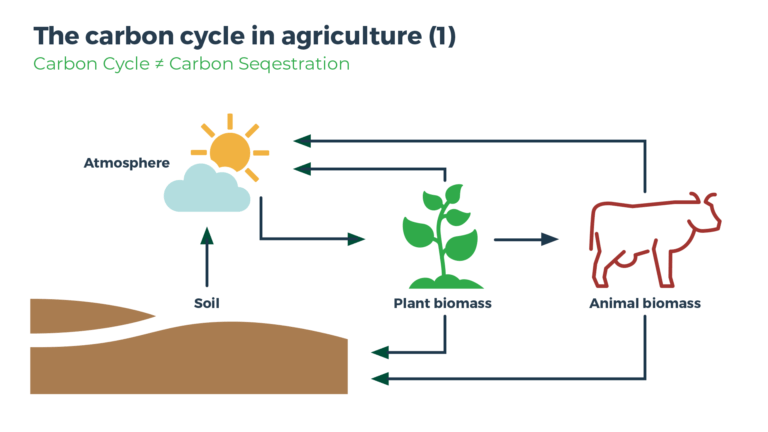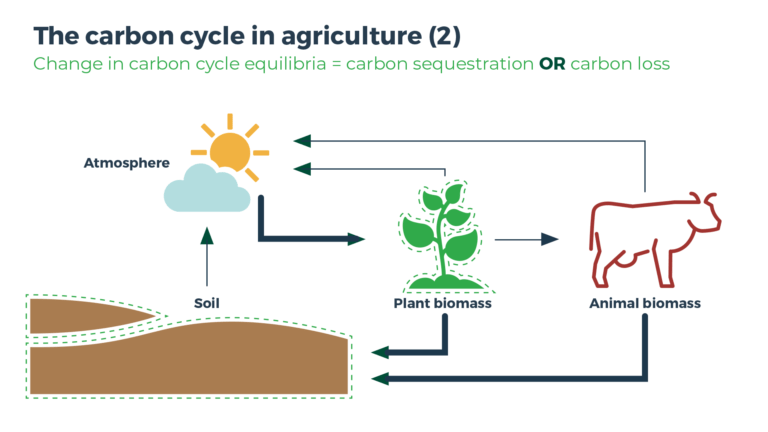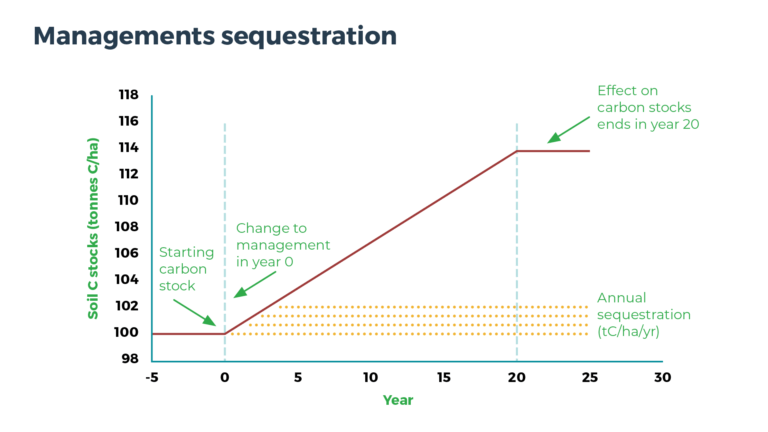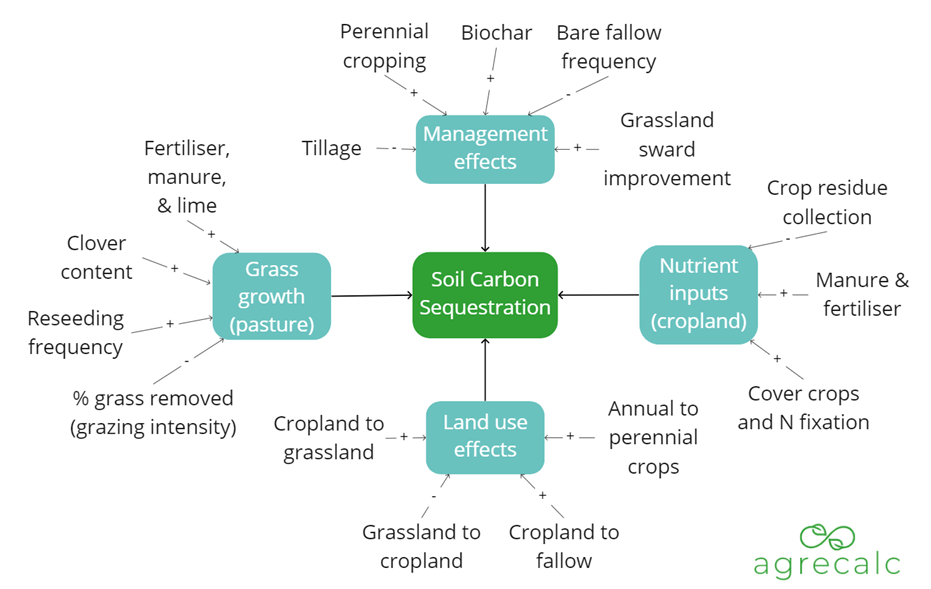Table of Contents
PLEASE NOTE: We have informed our customers that we have put a temporary pause to the reporting of results from Soil Carbon Module in the current version of Agrecalc.
Although we initially planned to move to a traffic light-based system, customer feedback indicated a preference for numerical values, which will be available again in the autumn 2024 upgrade.
We encourage you to still enter your data, as it will enable the recalculations to happen once the upgraded soil carbon module is released.
More information can be found in our blog.
Introduction to Soil Carbon Guide
The following soil carbon guide aims to help Agrecalc users understand and interpret results from the soil carbon module.
The first few sections of this guidance provide background information on soil carbon sequestration and the Agrecalc model. Later sections, which focus data entry and results interpretation, should be consulted to help users understand their specific soil carbon outputs.
We recommend further reading, on Understanding soil carbon in depth, its significance and paths to improvement (outside the soil carbon module in Agrecalc).
Soil Carbon Sequestration: The Basics
In agriculture, carbon flows through a natural cycle; carbon from the atmosphere is captured by plants as they grow and is recycled back to the atmosphere through decomposition. Without interference, this natural system exists in equilibrium, with soil carbon stocks maintained. Management practices can shift the balance between carbon storage and release, resulting in carbon sequestration or loss.
Soil carbon capture is the change in soil carbon stock estimates from one year to the next. Soil carbon can be thought of like a bank account; carbon stocks are the bank balance and sequestration is the income. Resting soil carbon stocks and are determined by climatic factors such as temperature, moisture content, as well as mineral composition, parent material and soil texture. Generally, soil carbon stocks in the UK vary from approximately 80–120 tonnes carbon per hectare to 30cm depth. Using the right soil sampling methods when it comes to sampling for Soil Organic Carbon (SOC) stocks can provide the best estimate and establish a baseline that you can use to re-measure year after year.
Though it is important to ensure soil carbon stocks do not decrease, farm management should focus on increasing soil carbon stocks through active sequestration. In addition to the benefits for global climate, soil carbon is also associated with improved soil functions, including soil structure, stability, drainage, trafficability, and nutrient supply. Agricultural practices can increase or decrease soil carbon stocks, leading to net sequestration or emission of soil carbon. Management practices, especially those concentrating on carbon insetting, may also protect existing carbon stocks but not necessarily lead to additional sequestration of soil carbon.

Carbon in plant tissues is recycled relatively quickly into the atmosphere, so the growth of plant material on its own cannot be considered long term sequestration. According to IPCC guidelines, biogenic carbon can only be considered captured if it is stored for 100 years (e.g. timber, increased soil carbon, biochar).

Our IPCC Soil Carbon Model
In our IPCC model, which is what we’re referring to in this soil carbon guide, changes to farm management cause changes to soil carbon stocks over a 20-year period. After year 20, it is assumed that soils reach a new stable state, and no further soil carbon sequestration takes place without additional changes in management (see figure 2). In reality, soil carbon changes may not occur evenly over time and the period of change may vary widely in length. However, to make carbon estimates workable at the farm level, a simplification of complex soil carbon interactions is necessary. For this reason, Agrecalc has adopted the current IPCC methods.

Agrecalc’s soil carbon module uses a series of decision trees to determine whether soil carbon levels under grassland or arable crops land are changing. A schematic diagram of all factors considered in the model is included in figure 3. The soil carbon decision trees consider:
- Underlying soil carbon stocks for the farm: baseline carbon stocks are determined using climatic information based on the farm postcode
- Land use change: For example, conversion of perennial grassland to annual cropland is associated with a decrease in soil carbon storage.
- Land management practices: This includes tillage of cropland and grassland grazing intensity.
- Input use and application: For example, manure application and cover cropping play a significant role in soil carbon sequestration.

The IPCC Tier 1 methods for soil carbon modelling multiply reference soil carbon stocks and stock change factors related to land use, management actions and inputs (IPCC, 2019). Figure 4 shows the generalised equation used to estimate soil carbon sequestration over 20 years.
Together, the decision trees and calculations in Agrecalc determine whether the farm is maintaining, increasing, or depleting soil carbon levels. As previously described, these changes are assumed to occur over a 20-year period. The soil carbon module therefore divides the total predicted change in soil carbon by 20 to provide an annual estimate of soil carbon change.

Data Entry for the Soil Carbon Module
To accurately interpret the results of the soil carbon module, it is essential to understand the input data which influences estimated soil carbon loss / gain.
The Land and Crops input section includes a screen for soil carbon-specific inputs. The soil carbon module also utilises other input data including livestock numbers and weights, pasture stocking intensity, manure management, and organic material application. The model also draws on several geospatial databases using the post code of the farm. These databases provide average data on soil types, climate, and grass growth productivity.
If you are having trouble explaining the results of the soil carbon module, it is worth double checking the following data in your input sheets:
- Organic matter applied to soils is an important source of carbon and will have a significant bearing on carbon sequestration. Organic matter can be either imported onto the farm or transferred from livestock enterprises.
- Manure management inputs must accurately represent the fractions of the reporting period animals are on pasture, on hill ground, and housed. This is used to estimate grazing intensity.
- Fraction of rotation under fallow should currently only include periods of bare fallow. Do not include periods when green manures are present.
- Clover content of grassland helps estimate grass growth. This input is especially crucial for farms using clover to help reduce fertiliser requirements. Clover content can be estimated visually (AHDB gives good guidance on the clover content).
- Number of years crop in the ground must be entered for soil carbon results to calculate.
If you are hoping to better understand the results of the soil carbon model, this section provides suggestions for why soil carbon might be increasing or decreasing. The previous section on data inputs should also be consulted to help interpret and troubleshoot soil carbon results. Figure 3 can also help explain dynamics of the soil carbon model.
If you’ve had soil sampling done on our farm or estate, make sure that it has been sampled and measured correctly.
Interpreting Soil Carbon Results
If the soil carbon module has an output of zero, and all Agrecalc inputs have been populated, this indicates soil carbon has reached a stable state. Soil carbon equilibrium is common on very extensively managed farms which operate similarly to natural grassland systems.
Grassland
Soil carbon gain on grassland means more organic material (in the form of grass biomass and manure) is added to the soil than is removed through grazing. The following factors might contribute to positive grassland sequestration values:
- Land use conversion from annual cropping to perennial grassland
- Low stocking rate (low grazing pressure)
- Short grazing duration (paddock / rotational grazing)
- High manure / organic material application
- Other improvements such as frequent reseeding, liming, clover seeding, and fertiliser application
Soil carbon loss from grassland suggests Agrecalc has estimated very high grazing pressure due to high energy demand from grazing animals and / or low predicted grass growth. The following factors might contribute to soil carbon loss:
- High stocking rate (high grazing pressure can lead to soil carbon loss)
- Set stocking of livestock
Minimal grassland improvements include manure application, reseeding, liming, and fertiliser application.
Arable cropland
Soil carbon gain on cropland means more organic material (in the form of crop residues, green manures, livestock manures, and other organic amendments) is being added to the soil than is being removed through crop harvest. The following factors might contribute to positive cropland sequestration values:
- Very significant application of manure, compost, or other organic materials
- Cultivation of perennial crops in rotation
- Presence of cover crops and / or nitrogen-fixing crops in rotation
- High crop yields with a significant fraction of the final crop left as residues
Because carbon is removed when arable crops are harvested, soil carbon loss is common for annual cropping systems unless significant amounts of carbon are reintroduced as manure or other organic amendments. The following factors might contribute to soil carbon loss on cropland:
- Conversion from grassland or perennial cropland to annual cropland
- Minimal application or manure, compost, or other organic materials
- Crop residue removal
- Full tillage
- Significant proportion of the year under bare fallow.
We hope that this soil carbon guide is comprehensive and useful. If you have any questions or queries, please do not hesitate to reach out to the Agrecalc team.

